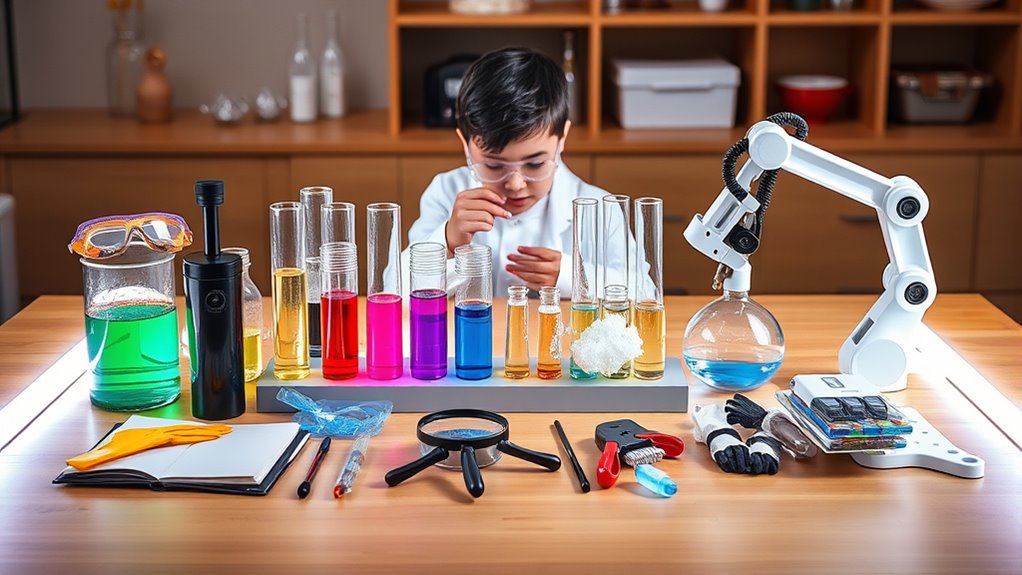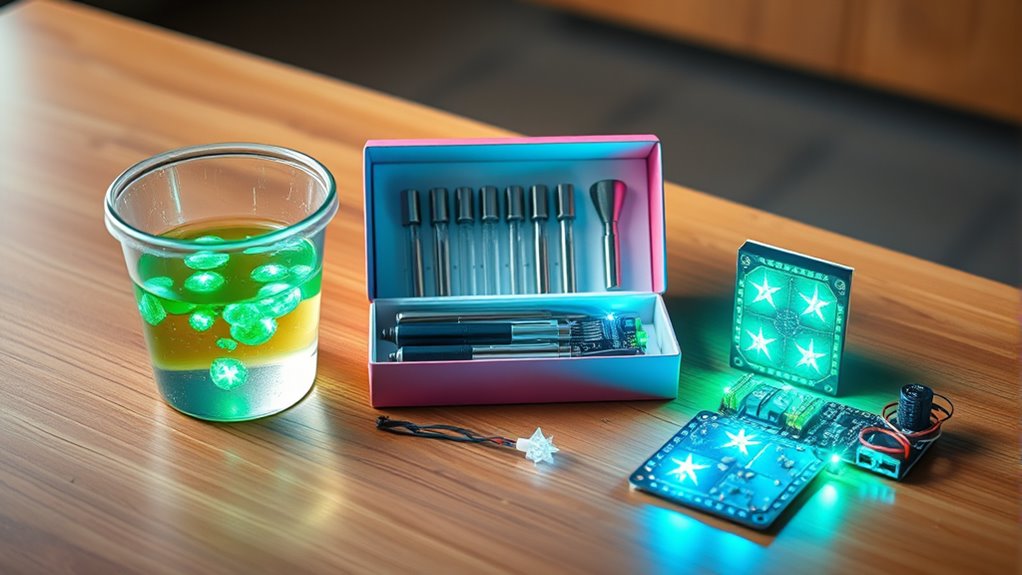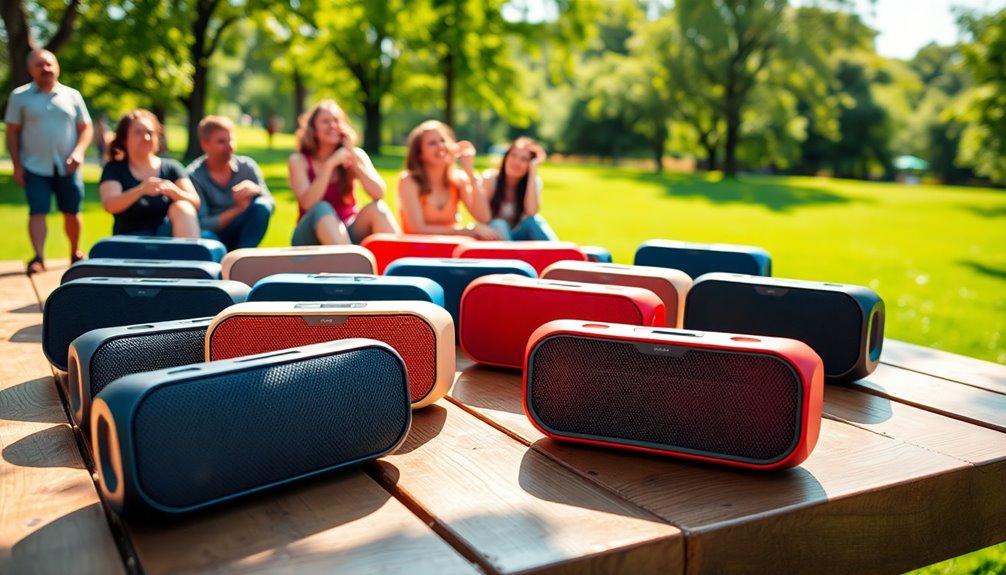If you want to spark your child’s curiosity in 2025, I recommend the Butterfly Edufields 30-in-1 STEM Kit, the 10-in-1 Robotics Kit, and a quality compound microscope. These kits promote hands-on learning across physics, biology, and engineering, keeping kids engaged with diverse experiments. They’re safe, durable, and designed for different ages. Want to discover how these tools can inspire their love for science? Keep exploring to learn more.
Key Takeaways
- Look for kits with diverse experiments across physics, chemistry, and biology to keep children engaged and foster broad scientific interests.
- Prioritize high-quality, durable components and clear instructions to ensure safe, effective, and long-lasting learning experiences.
- Choose age-appropriate kits with a balance of complexity and safety, suitable for children’s developmental stages.
- Opt for kits that promote critical thinking, problem-solving, and creativity through hands-on building and exploration activities.
- Consider educational value, curriculum alignment, and long-term engagement features to maximize curiosity and learning in 2025.
Butterfly Edufields 30-in-1 STEM Kits for Kids
If you’re looking for a science kit that sparks curiosity and promotes hands-on learning, the Butterfly Edufields 30-in-1 STEM Kit is an excellent choice for children aged 8 to 12 who enjoy building and experimenting. It offers over 30 projects involving electricity and magnetism, like electromagnetic cranes and electroscopes. With 100+ components, including wires, bulbs, and switches, kids can easily follow the detailed, step-by-step instructions to create engaging models. This kit encourages creativity, critical thinking, and scientific exploration, making it a perfect educational gift. Its compact size and durable design guarantee long-lasting fun and learning for young science enthusiasts.
Best For: children aged 8 to 12 who are curious about science, enjoy building projects, and want a hands-on, screen-free educational activity.
Pros:
- Offers over 30 engaging electricity and magnetism projects to stimulate creativity and scientific understanding.
- Includes 100+ components and a detailed instruction manual for easy, independent assembly.
- Promotes critical thinking, problem-solving skills, and long-term interest in STEM subjects.
Cons:
- Some small or intricate parts may be challenging for younger children to handle comfortably.
- A few users report issues with loose components or difficulty distinguishing between similar parts.
- Requires 2 AA batteries, which are not included, adding an extra step before use.
Butterfly Edufields 10-in-1 STEM Robotics Kit for Kids
The Butterfly Edufields 10-in-1 STEM Robotics Kit is an excellent choice for curious kids aged 8 to 12 who want to immerse themselves in hands-on robotics and engineering projects. With over 100 components, it enables children to build ten different robots, including line-following and obstacle-avoidance models, in about 15 minutes. The kit promotes learning in electronics, mechanics, and programming, fostering problem-solving and creativity. Its well-illustrated manual makes assembly straightforward, making it perfect for school projects or holiday gifts. Despite some fragile parts, the kit offers a fun, educational experience that sparks early interest in STEM fields.
Best For: curious kids aged 8 to 12 interested in hands-on robotics, engineering, and STEM projects that foster creativity and problem-solving skills.
Pros:
- Offers over 100 components enabling the construction of 10 different robotic models for diverse learning experiences
- Includes a well-illustrated manual that makes assembly easy and quick, ideal for young learners
- Promotes STEM education by teaching electronics, mechanics, and programming through interactive projects
Cons:
- Some parts are fragile, which may lead to breakage or assembly difficulties for children
- Inconsistent quality of components such as LEDs and connectors can affect project functionality
- Small parts and screws might be challenging for younger children to handle safely and effectively
Compound Microscope for Adults & Kids
Looking for a microscope that can grow with both kids and adults? I’ve found that a compound microscope with a wide magnification range (100X-2000X) is perfect for biological studies, cell observation, and microbiology. It offers lab-grade clarity, dual LED lighting, and adjustable focus, making it suitable for beginners and more advanced users alike. The included STEM kits, slides, and phone adapters encourage exploration from a young age. While some models have slight performance quirks, the sturdy build, portability, and educational value make this microscope a versatile tool for home, school, or hobbyist use. It’s an excellent way to spark curiosity across all ages.
Best For: beginners, students, and hobbyists of all ages seeking an affordable, versatile microscope for educational and exploratory purposes.
Pros:
- Wide magnification range (100X-2000X) suitable for various biological and microbiological studies
- Includes comprehensive STEM kits, slides, phone adapters, and portable design for easy exploration
- Lab-grade optical clarity, dual LED illumination, and adjustable focus for sharp, detailed images
Cons:
- Some models may not meet the advertised maximum magnification, with performance limitations reported
- User instructions, especially for mobile phone setup, can be inadequate or unclear
- Occasional issues with focusing mechanisms, zoom functionality, or regional power supply compatibility
Factors to Consider When Choosing a Science Kit

When selecting a science kit, I look at whether it’s suitable for my kid’s age and skill level to keep them engaged and safe. I also consider the quality of the experiments, how durable the materials are, and if the kit offers enough variety to maintain their interest. Finally, I keep an eye on the price to guarantee it provides good value without sacrificing educational quality.
Age Appropriateness
Choosing the right science kit depends heavily on your child’s age and developmental stage. Look for a kit labeled with an age range that matches your child’s abilities. For younger kids (ages 4-6), select kits with larger parts and simple experiments to guarantee safety and ease of use. Older children (ages 8-12) can handle more complex projects with smaller components, which challenge their skills without causing frustration. It’s also important to contemplate whether the content aligns with their current educational level to keep them engaged without feeling overwhelmed or bored. Age-appropriate kits often include safety features like non-toxic materials and rounded edges. Picking a kit suited to your child’s age helps build confidence while fostering a genuine interest in science.
Educational Content Quality
High-quality science kits provide clear, accurate, and age-appropriate educational content that helps kids grasp scientific concepts effectively. I look for kits with well-designed instructions, diagrams, and explanations that promote independent learning and minimize frustration. The educational value increases when the kit connects science to real-world applications, encouraging kids to think critically and solve problems. Reputable kits often align with educational standards or curriculum requirements, which ensures they supplement classroom learning properly. The depth and accuracy of the content directly influence a child’s understanding and long-term interest in science topics. A well-crafted kit not only teaches facts but also inspires curiosity and confidence, making learning enjoyable and meaningful. Ultimately, quality educational content is key to fostering a lasting love for science in young learners.
Safety and Durability
Ensuring safety and durability are vital factors when selecting a science kit for kids, as they directly impact both the child’s well-being and the kit’s longevity. I recommend choosing kits made from non-toxic, BPA-free materials to prevent any harm during experiments. Sturdy construction and reinforced parts are essential, as they help the kit withstand repeated use and accidental drops. For young children, guarantee small parts are securely assembled or have safety features to prevent choking hazards. Quality-tested wiring and connectors are important for consistent performance over time. Finally, look for kits with clear safety instructions and age-appropriate labels to guide proper handling and minimize risks. Prioritizing these aspects helps create a safe, durable, and enjoyable science experience for your child.
Variety of Experiments
A science kit that offers a variety of experiments can turn learning into an exciting adventure. When children explore different activities across physics, chemistry, biology, and engineering, they gain a broader understanding of science’s interconnectedness. This diversity keeps kids engaged longer by providing fresh challenges and prevents boredom. Multiple experiment types also help children discover their interests—whether it’s building circuits, studying microorganisms, or observing chemical reactions. A well-rounded kit encourages continuous learning and skill development, making it perfect for both beginners and more advanced young scientists. By offering a wide range of experiments, the kit nurtures curiosity, promotes creative problem-solving, and fosters a love for science that can last a lifetime.
Budget and Value
When choosing a science kit, it’s important to take into account how much value you’re getting for the price. I recommend considering the overall cost relative to the number and complexity of experiments included, ensuring your child gets plenty of engaging activities. Look for kits with high-quality components and detailed instructions, which can boost learning and reduce the need for extra purchases. Assess whether the kit offers long-term engagement through a variety of projects, justifying a higher price. Safety, durability, and the inclusion of essential tools also matter—these features add to the kit’s overall value and lifespan. Be cautious of cheaper options that may lack key parts or have lower-quality materials, as they can limit educational effectiveness and durability.
Frequently Asked Questions
Are These Science Kits Suitable for Different Age Groups?
You’re wondering if these science kits are suitable for different age groups. I’ve found that many kits are designed with specific ages in mind, making sure age-appropriate experiments and safety. Younger kids benefit from simple, colorful activities, while older children can tackle more complex projects. It’s important to check the recommended age range on each kit to ensure your child gets the most out of the experience and stays safe during play.
Do the Kits Include Safety Instructions for Children?
You’re wondering if the science kits include safety instructions for children. I can tell you that most reputable kits do include clear, detailed safety guidelines to guarantee kids use the materials safely. These instructions cover proper handling, protective gear, and adult supervision recommendations. I always recommend reviewing these safety instructions thoroughly before allowing your child to start experimenting, so both of you feel confident and secure during their scientific adventures.
Can These Kits Be Used Independently or Require Adult Supervision?
Imagine igniting your child’s passion for discovery—now, picture doing it safely. These science kits are designed for a range of ages; some can be used independently, fostering independence and confidence. However, I believe that adult supervision enhances safety and learning. I always stay nearby, guiding and supporting my child’s curiosity. That way, we turn every experiment into a memorable, safe adventure, fueling her love for science.
Are the Kits Compatible With Other Educational Tools or Resources?
When I look at these kits, I find they’re generally designed to work well alongside other educational tools. They often include compatible resources or can be complemented with books, online content, or classroom materials. I recommend checking each kit’s details, but most are versatile enough to enhance your child’s learning experience, making it easier to integrate into broader educational activities and foster a thorough curiosity.
What Is the Recommended Skill Level for Each Kit?
Imagine a young scientist excitedly exploring her first chemistry set; that’s how I see skill levels in science kits. Most kits are designed for specific ages or abilities—like beginner, intermediate, or advanced. I recommend matching the kit to your child’s current skills, ensuring it’s challenging yet achievable. For example, a beginner kit builds confidence, while an advanced one sparks deeper curiosity, making science both fun and educational.
Conclusion
Just like Alice’s curiosity led her down the rabbit hole, I believe the right science kit can unleash your child’s wonder and discovery. Whether they’re building robots or exploring the microscopic world, these kits are gateways to endless learning. So, pick one that sparks their imagination and watch them set out on their own extraordinary adventure—because every great scientist starts with a single, curious step into the unknown.














